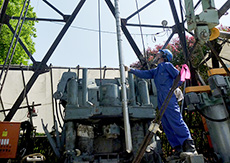Bulletin of the Geological Survey of Japan Top Page
Bulletin of the Geological Survey of Japan Vol.64 No.11/12 (2013)
Cover photograph | Table of Contents | Abstract
Cover photograph
Installing a strainmeter of the integrated groundwater observation well network for earthquake prediction of the Geological Survey of Japan, AIST
(Photograph by Satoshi Itaba)
Table of Contents
All the pages PDF : 64_11_full.pdf [3.6MB]
| Title | Author | |
|---|---|---|
| Article | ||
| Geochemical characteristics determined by multiple extraction from ion-adsorption type REE ores in Dingnan County of Jiangxi Province, South China | Kenzo Sanematsu and Yoshiaki Kon (313-330) |
64_11_01.pdf [6.35MB] |
| A method to estimate fault model of slow slip event using strainmeters of the integrated groundwater observation well network for earthquake prediction of the Geological Survey of Japan, AIST | Ryu Otani and Satoshi Itaba (331 − 340) |
64_11_02.pdf [1.76MB] |
Abstract
Geochemical characteristics determined by multiple extraction from ion-adsorption type REE ores in Dingnan County of Jiangxi Province, South China
Kenzo Sanematsu and Yoshiaki Kon
This article reports results of the multiple six-step extraction and single step extraction experiments conducted on five ion-adsorption ores and three weathered granite samples collected from the Dingnan County in Jiangxi Province, China. The six-step extraction consists of ion-exchangeable (reacted with sodium acetate) fraction, organic-matter (sodium pyrophosphate) fraction, amorphous Fe oxide and Mn oxide (hydroxylamine at 30˚C) fraction, Fe and Mn oxides (hydroxylamine at 60 ˚C) fraction, clays-sulfide (aqua regia) fraction and silicates (mixture acid) fraction. The five ion-adsorption ores from a mining site contained the ion-exchangeable elements by sodium acetate solution ranging from 174 to 388 ppm REY (43 – 68 % relative to whole-rock contents), from 1.1 to 3.5 ppm Th (3.7 – 9.4 %) and from 0.44 to 1.0 ppm U (14 – 25 %). Concentrations of the extracted elements from the ores by ammonium sulfate solution (single step) range from 170 to 346 ppm REY (42 – 64 %), from 0.03 to 0.31 ppm Th (0.1 – 0.8 %) and from 0.25 to 0.71 ppm U (8 – 18 %). The ion-exchangeable fraction is remarkably depleted in Ce relative to the other REY, and is slightly depleted in HREE and Y, compared with the whole-rock compositions. Thorium is dominantly present in the organic-matter fraction, and is moderately contained in the clay-sulfide fraction and in residue. Uranium is extensively present in the residue, silicates fraction, ion-exchangeable fraction, clays-sulfides fraction, and organic-matter fraction. Results of three weathered granite samples outside of a mine are not significantly different although the REY contents or percentages of ion-exchangeable REY are lower than the ores.
A method to estimate fault model of slow slip event using strainmeters of the integrated groundwater observation well network for earthquake prediction of the Geological Survey of Japan, AIST
Ryu Otani and Satoshi Itaba
A method to estimate fault parameters due to slow slip event was developed and tested. The method is based on a grid search to find the fault that minimizes the residual between the calculated and observed strain at strainmeter stations. According to a simulation study, it is shown that the method can retrieve the given fault parameters for the case of homogeneous fault slip while the extent of fault is underestimated and the slip amount is overestimated for inhomogeneous slip distribution cases. However, the area where the slip is relatively large and the moment magnitude of the slow slip event are well retrieved.
Geological Survey of Japan, AIST
- About GSJ
- Our Activities
- Purchase guide
-
Publications and Database
- information
- Bulletin of the Geological Survey of Japan
- bull2025(Vol.76)
- bull2024(Vol.75)
- bull2023(Vol.74)
- bull2022(Vol.73)
- bull2021(Vol.72)
- bull2020(Vol.71)
- bull2019(Vol.70)
- bull2018(Vol.69)
- bull2017(Vol.68)
- bull2016(Vol.67)
- bull2015(Vol.66)
- bull2014(Vol.65)
- bull2013(Vol.64)
- bull2012(Vol.63)
- bull2011(Vol.62)
- bull2010(Vol.61)
- bull2009(Vol.60)
- bull2008(Vol.59)
- bull2007(Vol.58)
- bull2006(Vol.57)
- bull2005(Vol.56)
- bull2004(Vol.55)
- bull2003(Vol.54)
- bull2002(Vol.53)
- bull2001(Vol.52)
- Bulletin of the Geological Survey of Japan(old)
- Annual Report on Active Fault and Paleoearthquake Researches
- Reports, Geological Survey of Japan
- CCOP-GSJ Groundwater Project Report
- CCOP Technical Bulletin
- Cruise Report
- Geological Hazards
- Learning and Education
- GSJ Database Collection
- Collection of links


